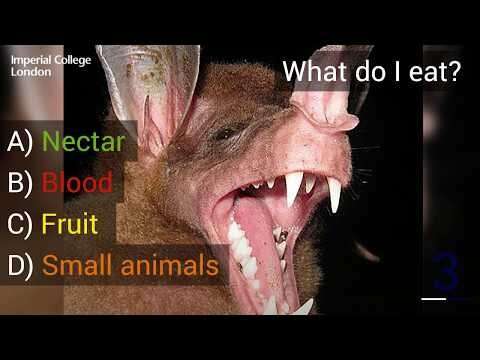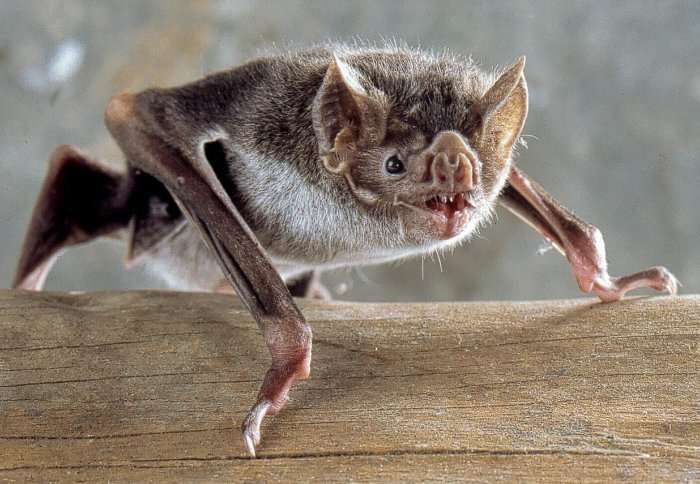What a group of bizarre-looking bats can tell us about the evolution of mammals

Bats with skulls and teeth adapted to a wide range of diets are helping scientists understand how major groups of mammals first evolved.
By analyzing the skulls of a group of bats that feed on everything from nectar to blood, researchers from the US and Imperial College London have identified how the bats have tweaked their development to adapt to different diets.
The insights, published in the journal Developmental Dynamics, could suggest how mammals as a whole evolved their diversity of diets and specialized skulls.
Many groups of bats hunt insects using echolocation, based on sound waves. But one group of bats in Central America and the Caribbean, known as New World leaf-nosed bats, have evolved a wide range of diets, and have the skulls and teeth to match.
For example, some species in the group have evolved very long snouts to feed on flower nectar, whereas others have evolved very flat faces to eat large fruit. Some species have evolved skulls and teeth that allow them to catch and eat small birds and rats, and others are able to drill into mammal skin and drink blood.
Faces reflecting diets
This diversity reflects the range of specialized diets (and skulls) seen across mammals as a whole—for example the fruit-eating bat faces resemble those of primates, and the bird- and rodent-eating bat faces resemble those of wolves and other carnivores.
However, Georges Cuvier, the founding father of palaeontology, already in the eighteenth century recognized that members of the same group of mammals (e.g. carnivores or rodents) tend to have very similar anatomical features, especially in their skulls and teeth. Across mammals each major group usually has one specialization—for example all primates have flat faces—whereas all this diversity is contained within one group for the New World leaf-nosed bats.
This makes these bats an ideal model for studying the evolution of mammals as a whole. While the bats are still very closely related, having only evolved in the last 15-20 million years, mammals diversified into their different groups not long after they first evolved, 100-120 million years ago.

Senior author Dr. Arkhat Abzhanov, from the Department of Life Sciences at Imperial and the Natural History Museum in London, said: "These bats can give us some idea how early mammalian diversity evolved without having to compare dogs, whales and monkeys, but instead by comparing relatively closely related species.
"Through our research, we found that differences observed during embryonic and juvenile development of bats can explain their adult specialized faces. This makes them an excellent group for further, more detailed study."
Model for evolution
The research team led by Dr. Abzhanov, which included members from Harvard University, Yale University and the American Museum of Natural History, investigated the skulls of adult, juvenile and embryonic bats.
Using high-resolution micro-CT scans to capture 3-D skull shapes, they examined the differences between each of the components of the skulls of different species, such as relative sizes and shapes of jaws and teeth.
They found that for highly specialized skulls, such as those for feeding on nectar or blood, a process called heterochrony strongly influenced their development.
Heterochrony refers to changes in the pace of development, or timing and order of important steps in development, while the animal is still growing as an embryo and a juvenile.
For example, the long snout of nectar-feeding bats is formed late in development as the snout-forming phase is greatly extended when compared to the normal timing in the ancestral insect-feeding bats. Fruit-eating bats evolved their unique primate-like faces by accelerating through the same developmental stages.
Dr. Abzhanov added: "Interestingly, their development as embryos and juveniles closely tracks predicted evolutionary changes from their common ancestor. This phenomenon, known as recapitulation, should allow us to uncover some of the underlying genetic mechanisms, for bats and potentially for mammals as a whole."
More information: Jasmin Camacho et al. Peramorphosis, an evolutionary developmental mechanism in neotropical bat skull diversity, Developmental Dynamics (2019). DOI: 10.1002/dvdy.90
Provided by Imperial College London



















